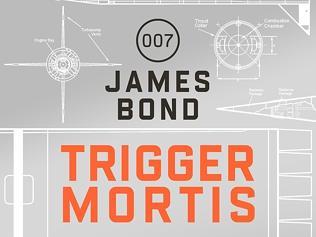Pussy Galore and James Bond fail to lift Horowitz’s Trigger Mortis
There’s Pussy Galore, fast cars and a Korean millionaire but the new Bond novel could have been more adventurous.

In the middle of last year, Anthony Horowitz was approached by the Ian Fleming estate to write the new James Bond novel. As the English writer explains in his afterword to Trigger Mortis, he leapt at the opportunity because he was a lifelong Bond fan, and because the estate showed him some unpublished Ian Fleming material that he would be allowed, if he so wished, to incorporate into his book.
Horowitz is known as a television writer (Midsomer Murders, Foyle’s War), and as a writer of young adult novels (the Alex Rider series) plus the odd Sherlock Holmes pastiche. He is able to dabble in many genres and I found his attempt to duplicate Fleming’s themes, subject matter and style completely convincing. Set just a few weeks after the events of Goldfinger in the late 1950s Trigger Mortis begins with a terrific little noirish prologue starring Thomas Keller, a disaffected German rocket scientist working for the Americans who accepts a bribe from SMERSH to sabotage the latest American rocket. He nervously takes the payoff and drives triumphantly home to his young wife, who promptly bumps him off and burns their house down to cover up the evidence.
Meanwhile Bond is ensconced with Pussy Galore in his opulent Chelsea flat. But there is trouble looming in paradise as Pussy outdrinks Bond at breakfast and flirts with just as many women. Work at the Secret Service is a welcome distraction. M tells Bond about a SMERSH plot to kill a British racing driver at the notorious Nurburgring and orders Bond to get in training to enter the race.
Bond meets the beautiful Logan Fairfax, who shows him how to be a Grand Prix driver in a surprisingly short amount of time. Back in Chelsea, vengeful allies of Auric Goldfinger kidnap Pussy Galore and prepare to murder her with gold paint (something MythBusters proved was impossible) but Bond and Logan save her in dramatic fashion.
After all the excitement Bond doesn’t get the girl but, a few scenes later, Pussy Galore does, neatly disposing of Bond’s two love interests and leaving him free to meet the real romantic lead of the book, Jeopardy Lane, a US Treasury agent posing as a journalist at the Grand Prix.
Bond heads to the big race in Germany. Mercifully there is little Jeremy Clarkson-style pontificating about cylinders and engines, and Fleming’s original material (about 500 words) on the Nurburgring is incorporated with ease.
At a post-race party at Korean millionaire Sin Jai-seong’s medieval castle, Bond encounters Jeopardy rummaging through Sin’s private papers. She finds several photographs of secret American rocket launching sites before the alarm trips and Bond and Jeopardy have to flee for their lives. Sin, it turns out, is a psychopath who hates America because of the Korean War. He has allied with SMERSH to hatch a typically nutty plan to set back the American space program by sabotaging a US rocket in midflight and making it look as if the debris fell on New York by blowing up fake rocket remains under the Empire State Building.
With these elements in place, the second half of the novel deals with Bond trying to thwart Sin’s scheme in a series of exciting escapes, fights and chases. Horowitz does well to mimic the structure of a Fleming novel and I smiled at his clever use of ‘‘Easter eggs’’ to pay homage to other books and characters in Fleming’s world. Some of Fleming’s ticks have been left in: luxury brand worship and name-dropping; others have been sensibly cut: Bond doesn’t drone on about ‘‘pansies’’ ruining the empire, as he sometimes does in the Fleming books.
I do wonder, though, at Horowitz choosing a sadistic Korean to be the centrepiece villain, given the strange anti-Korean rhetoric running throughout Goldfinger , which infamously includes this unpleasant little paragraph: “Bond intended to stay alive on his own terms. Those terms included putting Odd-Job or any other Korean firmly in his place [who] in Bond’s view were lower than apes in the mammalian hierarchy.’’
Later in the same novel Bond calls Odd-Job an ape-man, we learn that Koreans love raping white women and Goldfinger gives his delighted Korean henchman a cat to eat for dinner. A villain from another country would perhaps have been a shrewder choice for Trigger Mortis.
A Bond novel is only as good as the girl, the car and the baddie, and although Jeopardy is a great foil and the car is a Maserati 250F, Sin is too much of a chilly, one-dimensional sadist to be interesting.
Bond too isn’t as charismatic as he could be. Horowitz has chosen to model his lead closely on the Bond of the novels, not the Bond of the films, and the former can be a dull old stick at times. Sean Connery in particular added the charm and humour to the role that most people now associate with the character.
Horowitz’s prose style is workmanlike and steady, which is fine if all you want is to turn the pages, and do so quickly. Trigger Mortis is the least challenging of the four James Bond novels the estate has published since 2008. Sebastian Faulks brought an intellectual panache and a more introspective approach to Devil May Care, Jeffery Deaver delivered a certain muscularity to Carte Blanche and William Boyd’s Solo had political nous and a sharp satirical edge.
There is nonetheless a lot to like in Trigger Mortis and it is a serviceable addition to the revamped Bond canon. Fervent fans and completists will likely not be disappointed, but I found myself wanting more.
Horowitz is an intelligent and thoughtful man, and if he had taken a longer time to think about his subject matter and stretched the boundaries of his commission, he could have turned in something a bit more interesting and adventurous.
Adrian McKinty’s most recent novel is Gun Street Girl.
Trigger Mortis
By Anthony Horowitz
Orion, 320pp, $29.99


